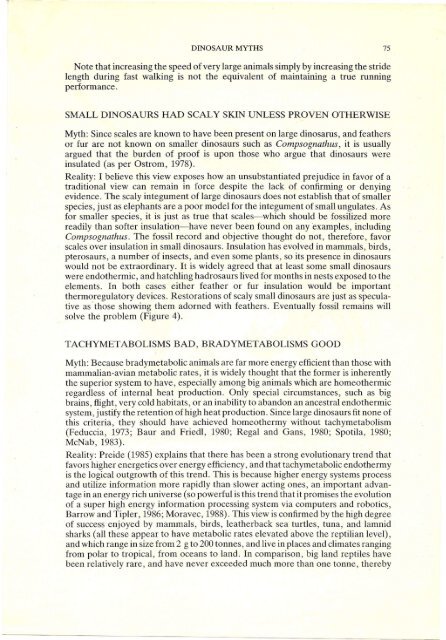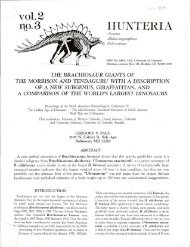THE MANY MYTHS, SOME OLD, SOME NEW, OF ... - Gregory S. Paul
THE MANY MYTHS, SOME OLD, SOME NEW, OF ... - Gregory S. Paul
THE MANY MYTHS, SOME OLD, SOME NEW, OF ... - Gregory S. Paul
Create successful ePaper yourself
Turn your PDF publications into a flip-book with our unique Google optimized e-Paper software.
DINOSAUR <strong>MYTHS</strong> 75<br />
Note that increasing the speed of very large animals simply by increasing the stride<br />
length during fast walking is not the equivalent of maintaining a true running<br />
performance.<br />
SMALL DINOSAURS HAD SCALY SKIN UNLESS PROVEN O<strong>THE</strong>RWISE<br />
Myth: Since scales are known to have been present on large dinosarus, and feathers<br />
or fur are not known on smaller dinosaurs such as Compsognathus, it is usually<br />
argued that the burden of proof is upon those who argue that dinosaurs were<br />
insulated (as per Ostrom, 1978).<br />
Reality: I believe this view exposes how an unsubstantiated prejudice in favor of a<br />
traditional view can remain in force despite the lack of confirming or denying<br />
evidence. The scaly integument of large dinosaurs does not establish that of smaller<br />
species, just as elephants are a poor model for the integument of small ungulates. As<br />
for smaller species, it is just as true that scales-which should be fossilized more<br />
readily than softer insulation-have never been found on any examples, including<br />
Compsognathus. The fossil record and objective thought do not, therefore, favor<br />
scales over insulation in small dinosaurs. Insulation has evolved in mammals, birds,<br />
pterosaurs, a number of insects, and even some plants, so its presence in dinosaurs<br />
would not be extraordinary. It is widely agreed that at least some small dinosaurs<br />
were endothermic, and hatchling hadrosaurs lived for months in nests exposed to the<br />
elements. In both cases either feather or fur insulation would be important<br />
thermoregulatory devices. Restorations of scaly small dinosaurs are just as speculative<br />
as' those showing them adorned with feathers. Eventually fossil remains will<br />
solve the problem (Figure 4).<br />
TACHYMETABOLISMS BAD, BRADYMETABOLISMS GOOD<br />
Myth: Because bradymetabolic animals are far more energy efficient than those with<br />
mammalian-avian metabolic rates, it is widely thought that the former is inherently<br />
the superior system to have, especially among big animals which are homeothermic<br />
regardless of internal heat production. Only special circumstances, such as big<br />
brains, flight, very cold habitats, or an inability to abandon an ancestral endothermic<br />
system, justify the retention of high heat production. Since large dinosaurs fit none of<br />
this criteria, they should have achieved homeothermy without tachymetabolism<br />
(Feduccia, 1973; Baur and Friedl, 1980; Regal and Gans, 1980; Spotila, 1980;<br />
McNab, 1983).<br />
Reality: Pre ide (1985) explains that there has been a strong evolutionary trend that<br />
favors higher energetics over energy efficiency, and thattachymetabolic endothermy<br />
is the logical outgrowth of this trend. This is because higher energy systems process<br />
and utilize information more rapidly than slower acting ones, an important advantage<br />
in an energy rich universe (so powerful is this trend that it promises the evolution<br />
of a super high energy information processing system via computers and robotics,<br />
Barrow and Tipler, 1986; Moravec, 1988). This view is confirmed by the high degree<br />
of success enjoyed by mammals, birds, leatherback sea turtles, tuna, and lamnid<br />
sharks (all these appear to have metabolic rates elevated above the reptilian level),<br />
and which range in size from 2 g to 200 tonnes, and live in places and climates ranging<br />
from polar to tropical, from oceans to land. In comparison, big land reptiles have<br />
been relatively rare, and have never exceeded much more than one tonne, thereby









